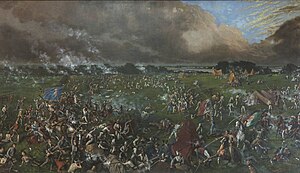Battle of San Jacinto
| Battle of San Jacinto | |||||||
|---|---|---|---|---|---|---|---|
| Part of the Texas Revolution | |||||||
 The Battle of San Jacinto-1895 painting by Henry Arthur McArdle (1836–1908) |
|||||||
|
|||||||
| Belligerents | |||||||
|
|
Texian rebels | ||||||
| Commanders and leaders | |||||||
|
Antonio López de Santa Anna (POW) Manuel Fernández Castrillón † Juan Almonte (POW) Martín Perfecto de Cos (POW) |
Sam Houston W Thomas J. Rusk James C. Neill W Mirabeau B. Lamar Sidney Sherman |
||||||
| Strength | |||||||
| 1,360 1 cannon |
910 2 cannons |
||||||
| Casualties and losses | |||||||
| 650 killed 208 wounded 300 captured |
11 killed or fatally wounded 30 wounded |
||||||
|
|
|||||||
Coordinates: 29°44′56″N 95°04′49″W / 29.748889°N 95.080278°W
Decisive Texian victory;
The Battle of San Jacinto, fought on April 21, 1836, in present-day Harris County, Texas, was the decisive battle of the Texas Revolution. Led by General Sam Houston, the Texian Army engaged and defeated General Antonio López de Santa Anna's Mexican army in a fight that lasted just 18 minutes.
Santa Anna, the President of Mexico, was captured and surrendered the following day and held as a prisoner of war. Three weeks later, he signed the peace treaty that dictated that the Mexican army leave the region, paving the way for the Republic of Texas to become an independent country. These treaties did not specifically recognize Texas as a sovereign nation, but stipulated that Santa Anna was to lobby for such recognition in Mexico City. Sam Houston became a national celebrity, and the Texans' rallying cries from events of the war, "Remember the Alamo!" and "Remember Goliad!," became etched into Texan history and legend.
General Antonio López de Santa Anna was a proponent of governmental federalism when he helped oust Mexican president Anastasio Bustamante in December 1832. Upon his election as president in April 1833, Santa Anna switched his political ideology and began implementing centralist policies that increased the authoritarian powers of his office. His abrogation of the Constitution of 1824, correlating with his abolishing local-level authority over Mexico's state of Coahuila y Tejas (Coahuila and Texas), became a flashpoint in the growing tensions between the central government and its Tejano and Anglo citizens in Texas. While in Mexico City awaiting a meeting with Santa Anna, Texian empresario Stephen F. Austin wrote to the Béxar ayuntamiento (city council) urging a break-away state. In response, the Mexican government kept him imprisoned for most of 1834.
...
Wikipedia

